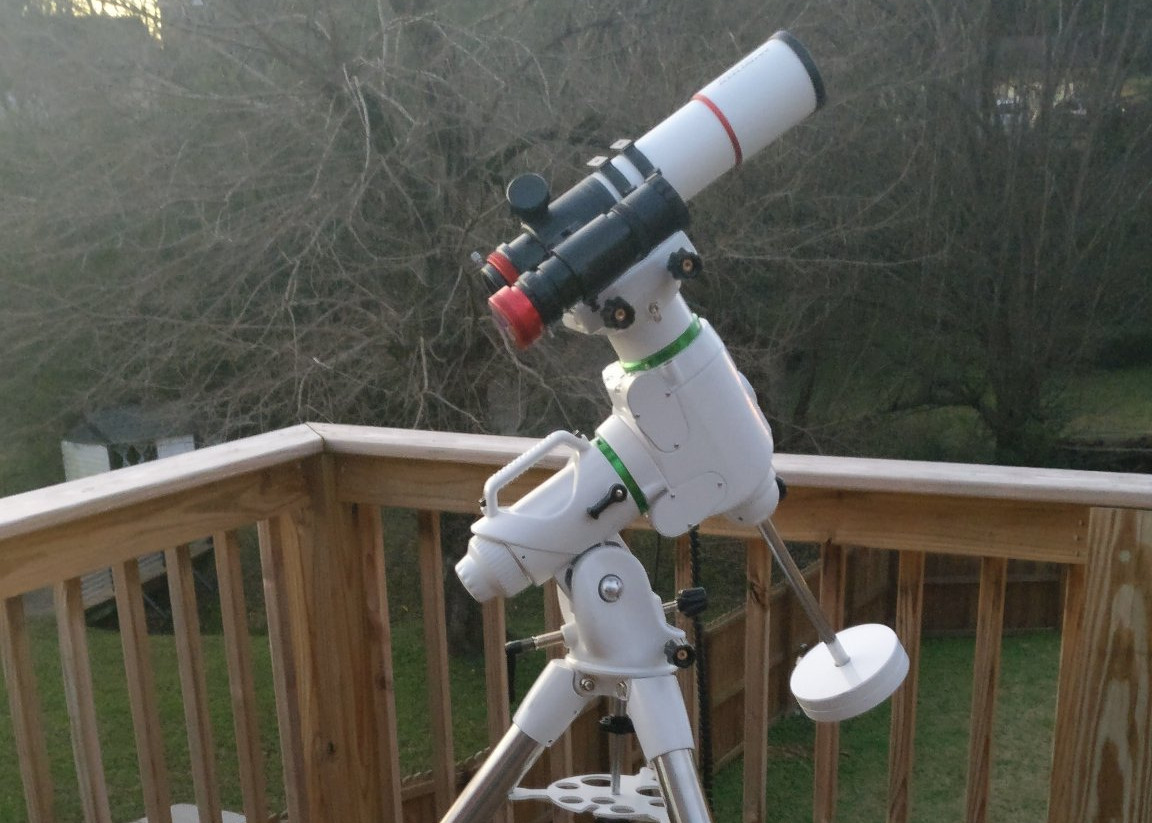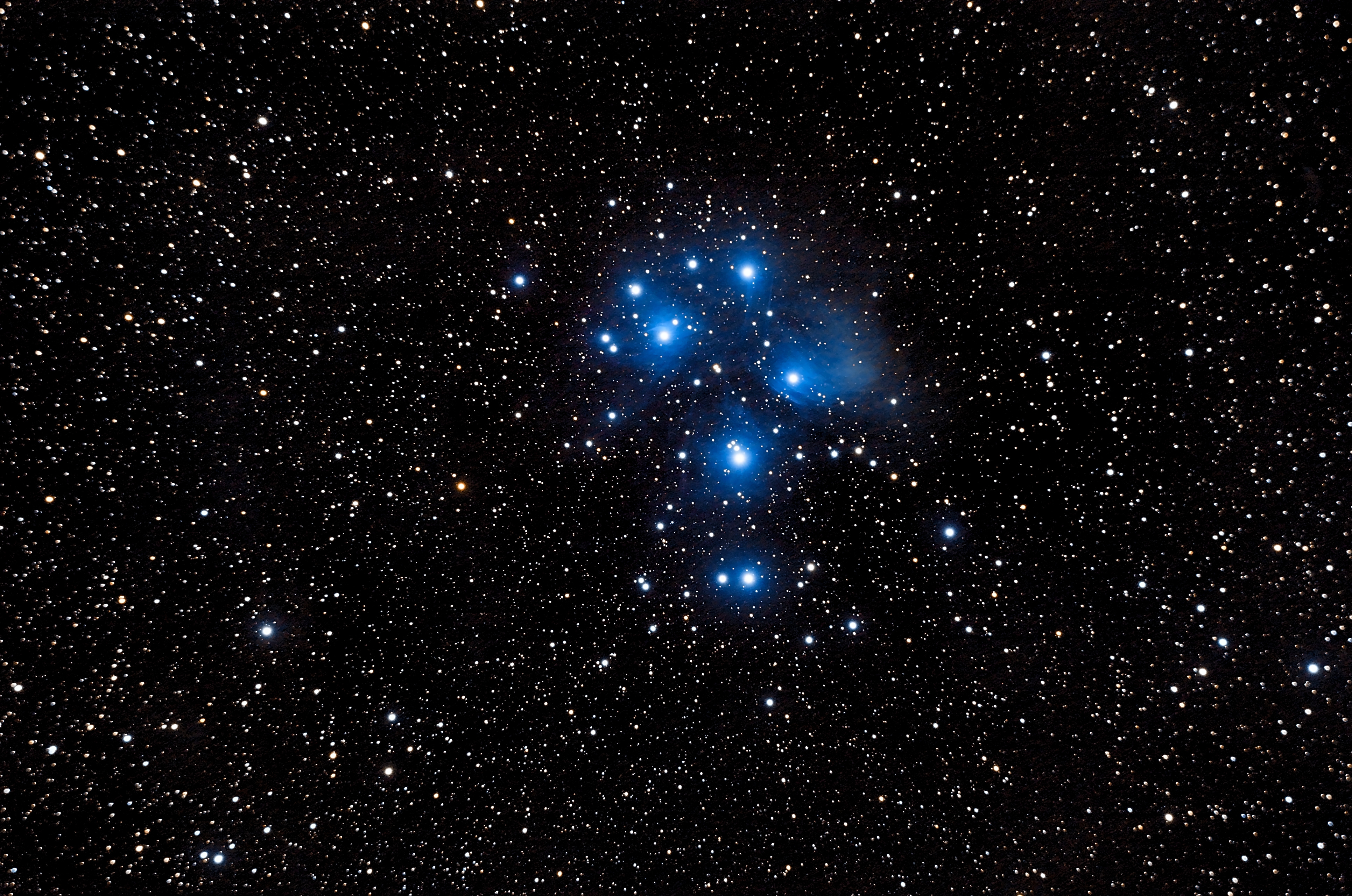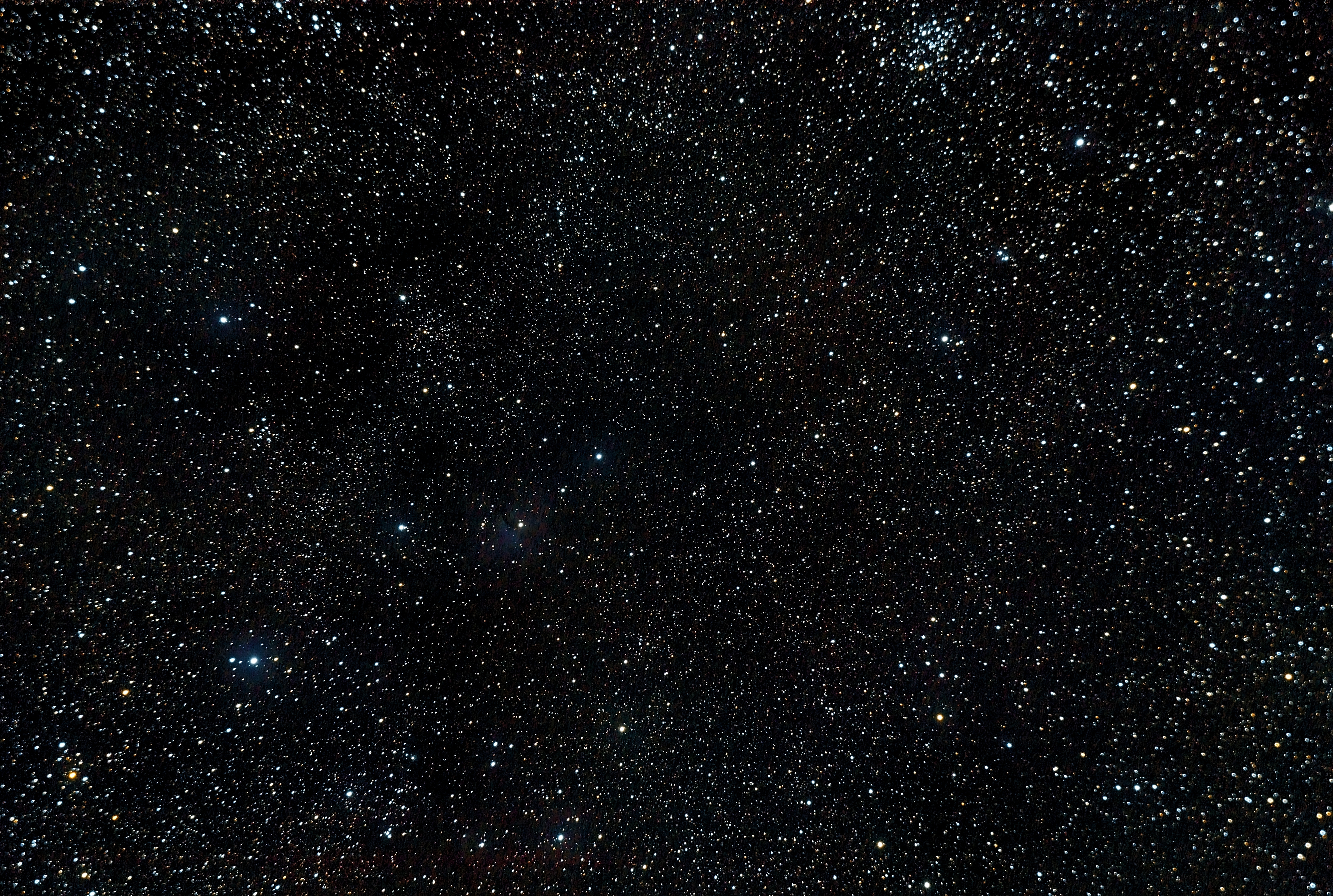misc
09 Jan 2019Happy new year! Winter is upon us, and with it, clouds and cold. I didn’t do much for a few months, but we finally had a few warmer clear nights, so I did a little bit of experimenting.
One thing I’ve been wanting to play with is autoguiding. Modern equatorial tracking mounts are amazing devices, but being mechanical devices, they aren’t perfect – even the best mount will “drift” a bit from what it’s tracking with the motion of the earth. The result of this is that over the course of a longer exposure, your photo can be ever so slightly blurry, losing a lot of potential detail. One way to correct this is by using a second telescope, another camera, and a computer. You piggyback a smaller (usually wider-field) telescope on your main “imaging” telescope and then use software on the laptop to pick a star and track it for movement – if it drifts from where it was, the software sends corrective instructions to move the mount back in place. The result looks something like this:
This is by far the least of my problems, but I wanted to give it a whirl anyway. I did a test-run of Andromeda (an easy target) with the guiding telescope and software active:
- Subject: Andromeda (M31)
- Camera: Sony A7S II
- Telescope: Astro-Tech AT72EDII
- Guide scope: Orion 13022 Deluxe Mini 50mm
- Guide Camera: ZWO ASI120MC-S
- ISO: 400
- Shutter Speed: 121”
- Light Frames: 20
- Dark Frames: 20
- Flat Frames: 20
- Offset Frames: 20
- Software: Pixinsight - DynamicCrop, DynamicBackgroundExtraction, Background Neutralization, Color Calibration, SCNR noise reduction, Histogram Transformation, Curves Transformation, Unsharp Mask
Frankly, it .. didn’t go well. Clouds moved in, so I didn’t get a ton of exposures to begin with. The guiding seemed particularly sensitive to any jostling, such that when I went out there in between exposures, it’d lose the guide star. As far as objective comparisons go it’s pretty terrible as well, since it was different ISO, longer exposure, and in the city w/ lots of light pollution and some clouds. But, at least I got some experience playing with the gear and software. In general, it’s kindof a pain in the ass. I’m still waffling on whether this will be part of my regular setup going forward. They do make auto-guiding all-in-one devices you can buy, but the reviews on them are mixed. We’ll see.
Following this, I didn’t do much for a few months – lots of rain, lots of clouds. I finally had a weekend with nice weather and decided to get out the telescope. Boy, in some ways this stuff is not at all like riding a bike – I was out of practice! It took me longer than normal to get the mount setup and aligned. I didn’t bother with the autoguiding setup, since it had been a while and I was rusty anyway. This was also my first time doing astrophotography with a winter sky – was nice, if disorienting, to be able to choose some different targets. First up was Pleiades – which I’ve attempted before, but with pretty terrible results. In the summer, Pleiades is only rising very early in the morning, so usually by the time I tried it, I was already exhausted and ready to go to bed, so they were never particularly long exposures. In the winter, though, it’s rising early and so I had a chance to take my time and do it right. It turned out much nicer:
- Subject: Pleiades (M45)
- Camera: Sony A7S II
- Telescope: Astro-Tech AT72EDII
- ISO: 1250
- Shutter Speed: 30””
- Light Frames: 237
- Dark Frames: 40
- Flat Frames: 20
- Offset Frames: 20
- Software: Pixinsight - DynamicCrop, DynamicBackgroundExtraction, Background Neutralization, Color Calibration, SCNR noise reduction, Histogram Transformation, Curves Transformation, Unsharp Mask
Managed to get a decent amount of the nebulosity for a change! Still not great due to all the light pollution I’m fighting at home, but all things considered I was pretty pleased. I’d like to try Pleiades sometime from darker skies.
Next, I thought I’d try a shot of the Orion nebula but not cropped and framed such that I might get some of the flame/horsehead nebula area in the frame. I failed, but got a wider-field perspective on the area, in any event:
- Subject: Pleiades (M45)
- Camera: Sony A7S II
- Telescope: Astro-Tech AT72EDII
- ISO: 1250
- Shutter Speed: 30”
- Light Frames: 120
- Dark Frames: 40
- Flat Frames: 20
- Offset Frames: 20
- Software: Pixinsight - DynamicCrop, DynamicBackgroundExtraction, Background Neutralization, Color Calibration, SCNR noise reduction, Histogram Transformation, Curves Transformation, Unsharp Mask
I finished up the night as usual with an exhaustion-fueled Bad Decision and pointed my telescope at IC 2177. IC 2177, however, is mostly hydrogen-alpha nebulosity and pretty much pointless to take a photo of in LRGB from the city:
- Subject: IC 2177 region
- Camera: Sony A7S II
- Telescope: Astro-Tech AT72EDII
- ISO: 1250
- Shutter Speed: 30”
- Light Frames: 120
- Dark Frames: 40
- Flat Frames: 20
- Offset Frames: 20
- Software: Pixinsight - DynamicCrop, DynamicBackgroundExtraction, Background Neutralization, Color Calibration, SCNR noise reduction, Histogram Transformation, Curves Transformation, Unsharp Mask
You can actually see the tiniest bit of nebulosity, and some clusters – M50 at the top, and NGC 2343 and NGC 2335 center left. Still, all in all a pretty pointless photo.
A few nights later we had a balmy evening with clear skies, so I decided to try something the flame and horsehead nebula area. I knew I’d need to gather a lot of light, so I dedicated the night to it and did around 360 light exposures:
- Subject: NGC 2024 and IC 434
- Camera: Sony A7S II
- Telescope: Astro-Tech AT72EDII
- ISO: 1000
- Shutter Speed: 30”
- Light Frames: 361
- Dark Frames: 40
- Flat Frames: 20
- Offset Frames: 20
- Software: Pixinsight - DynamicCrop, DynamicBackgroundExtraction, Background Neutralization, Color Calibration, SCNR noise reduction, Histogram Transformation, Curves Transformation, Unsharp Mask
I am pleased with how this turned out – I didn’t expect to get much from the city, since these nebulas are much fainter than Orion, and it’s complicated by a few very bright stars, but for a bortle 8 city zone, I think it’s pretty cool!





